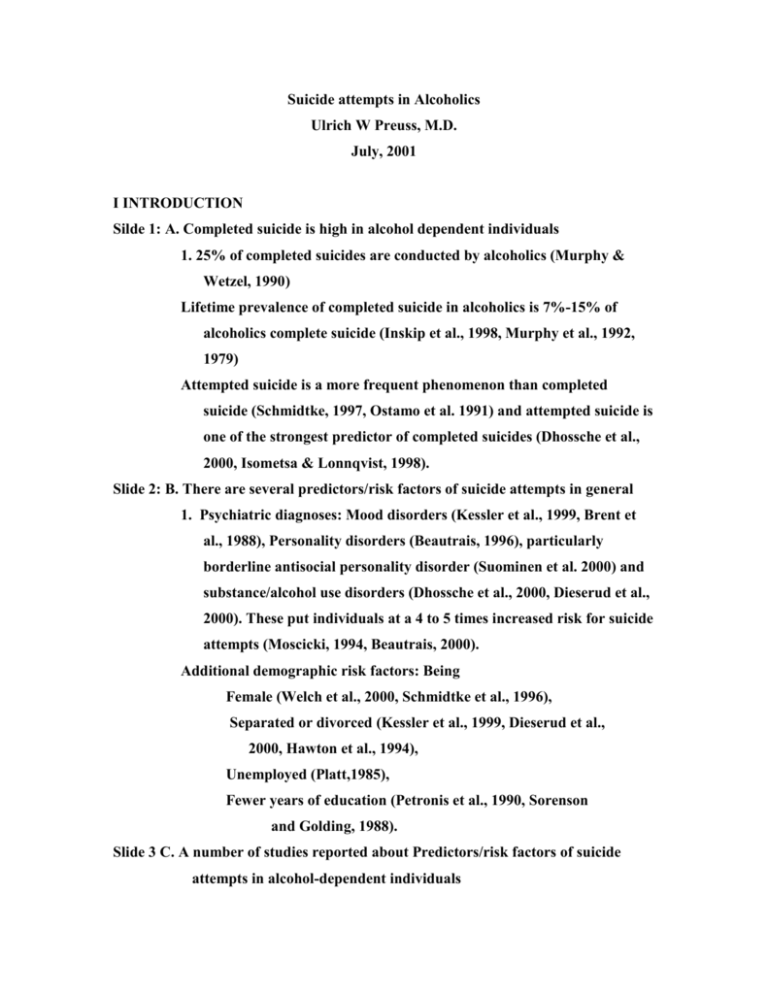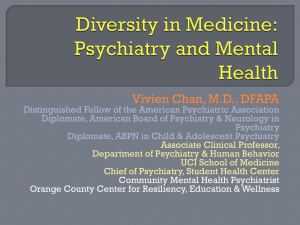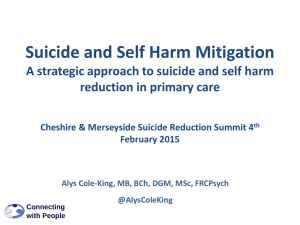this Outline - Alcohol Medical Scholars Program
advertisement

Suicide attempts in Alcoholics Ulrich W Preuss, M.D. July, 2001 I INTRODUCTION Silde 1: A. Completed suicide is high in alcohol dependent individuals 1. 25% of completed suicides are conducted by alcoholics (Murphy & Wetzel, 1990) Lifetime prevalence of completed suicide in alcoholics is 7%-15% of alcoholics complete suicide (Inskip et al., 1998, Murphy et al., 1992, 1979) Attempted suicide is a more frequent phenomenon than completed suicide (Schmidtke, 1997, Ostamo et al. 1991) and attempted suicide is one of the strongest predictor of completed suicides (Dhossche et al., 2000, Isometsa & Lonnqvist, 1998). Slide 2: B. There are several predictors/risk factors of suicide attempts in general 1. Psychiatric diagnoses: Mood disorders (Kessler et al., 1999, Brent et al., 1988), Personality disorders (Beautrais, 1996), particularly borderline antisocial personality disorder (Suominen et al. 2000) and substance/alcohol use disorders (Dhossche et al., 2000, Dieserud et al., 2000). These put individuals at a 4 to 5 times increased risk for suicide attempts (Moscicki, 1994, Beautrais, 2000). Additional demographic risk factors: Being Female (Welch et al., 2000, Schmidtke et al., 1996), Separated or divorced (Kessler et al., 1999, Dieserud et al., 2000, Hawton et al., 1994), Unemployed (Platt,1985), Fewer years of education (Petronis et al., 1990, Sorenson and Golding, 1988). Slide 3 C. A number of studies reported about Predictors/risk factors of suicide attempts in alcohol-dependent individuals Risk factors for suicide attempts reported in alcoholic samples are the same as in other samples Additional risk factors refer to characteristics of alcohol dependence including: Family history of alcoholism, (Schuckit, 1986) Early onset of drinking and alcohol dependence (Hesselbrock et al., 1988, Roy, 1993) Previous treatment for alcohol dependence (Black et al., 1986, Schuckit, 1986). Slide 4 D. Problems with previous research 1. Most studies use imprecise terminology. 2. Study samples are mainly small (Hewitt et al., 1998: n=39, Suominen et al., 1997: n = 118) 3. Studies do not differentiate between independent and induced psychiatric disorders Slide 5 E. Aim of the study and hypotheses 1. Identify and confirm risk factors for suicide attempts in a large, family based sample of alcoholics using the COGA dataset. 2. Test the robustness of these predictors in a multivariate design (logistic regression) 3. Look at suicide attempts in families of alcoholics with and without a history of suicide attempts. Slide 6: F. Hypotheses: Alcoholics with a history of suicide attempts: 1. Show different sociodemographic characteristics by being more female younger unemployed separated divorced uneducated 2. They show a more severe course of alcoholism 3. Higher psychiatric comorbidity 4. More suicide attempts, psychiatric comorbidity and substance use disorders in first-degree relatives II. METHODS: Slide 7: A The Collaborative Study on the Genetics of Alcoholism (COGA) sample: 1. 3,190 alcohol-dependent individuals were included in this analysis 2. Included probands, selected controls and family members 3. Semistructured interviews (SSAGA) were used to obtain information on a. Suicidal behavior b. Socioeconomic characteristics c. Psychiatric comorbidity, d. Substance use disorders e. Characteristics of alcohol dependence 4. Univariate and multivariate statistics were used to test hypotheses Slide 8 B. Sample: These alcohol dependent individuals were assigned into two groups: 1. Group 1: alcohol-dependent individuals with a history suicide attempts 2. Group 2: alcohol-dependent individuals without a history suicide attempts III. RESULTS Slide 9: A. First hypothesis: There are differences in sociodemographic characteristics between Groups 1 and 2 Group 1 is younger and had less years of education They have a significant higher proportion of females, are more often unemployed and divorced or separated. Additional factors: They were less likely to have a college degree and were more often unemployed. No differences regarding ethnicity were found. Slide 10: B. Second hypothesis: Group 1 subjects show a more severe course of alcohol dependence showing An earlier onset of alcohol dependence A higher number of DSM III R alcohol dependence criteria endorsed More alcohol-related violence A higher number of alcohol related physical problems. Additional factor: they received more treatment because of their alcohol dependence Slide 11: C. Third hypothesis: Group 1 individuals have more substance use disorders and higher psychiatric comorbidity by showing A significantly higher number of substances dependent on including marihuana, amphetamine and opiates. A higher number of psychiatric disorders including independent and induced depression, mania, panic disorders, and social phobia. Slide 12: D. Fourth hypothesis: First-degree relatives of Group 1 had a significantly higher frequency of suicide attempts than relatives of Group 2. This is due to higher rates of suicide attempts in fathers and siblings of suicidal alcoholics. E. No differences were found regarding frequency of alcohol dependence, psychiatric and other drug dependence. Slide 13: F. Regression analysis: A number of suicide attempt risk factors remained significant in a multivariate approach. In the equation: Older age Being unemployed Induced and independent depression, Number of DSMIIIR alcohol dependence criteria, Number of alcohol-related physical problems, Separated/ divorced, Number of alcohol-related violence Not in the equation: Alcohol dependence age of onset Being married 3. Slight differences in the profile of risk factors between males and females. IV Conclusion: Slide 14 A. Alcohol-dependent individuals with a history of suicide attempts: 1. Are more severely impaired due to psychiatric comorbidity, other substance use disorders and alcohol-dependence characteristics. 2. Have first degree relatives who show higher rate of suicide attempts 3. When in treatment: screen and treat psychiatric comorbidity to prevent suicide attempts and subsequent completed suicide.









